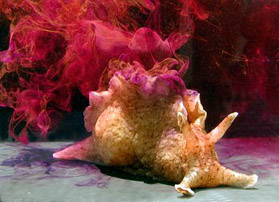Overview
Brief Summary
Morphology
Physical Description
Ecology
Local Distribution and Habitats
Biogeographical Distribution
Invasive Potential
Biology
Life history
Feeding
Defense
Locomotion
Scientific significance
Use as a model organism
Conservation
Threats
Wikipedia
References & More Information
Bibliographies
Search the Web | Defense
If disturbed or made to feel threatened, Aplysia will release plumes of characteristic purple ink, although the colour of the ink released can be slightly altered by the animals algal diet (Tony 1982). The purple ink is thought to be both a chemical and visual deterrent formed by two repugnant glands; one ink gland and one opaline gland which releases a highly viscous, polymerised liquid (Derby 2007). Due to the generally slow movements of many Aplysia species however, it is believed that a simple visual distraction would not provide sufficient time for escape and therefore many believe that the ink may also have strong chemosensory cues (Tony 1982). For example, the ink has been reported in some control studies to initiate feeding response in pests such as crustaceans. This manor of distraction would keep the pest or predator busy while the Aplysia escaped (Tony 1982; Derby 2007).

Picture of A. californica inking reproduced with courtesy of Genevieve Anderson. |
|